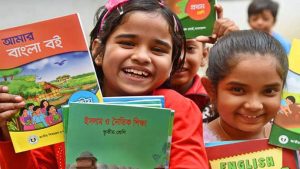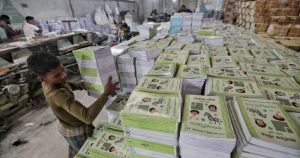Books needed 40 million, but less than 4 million were printed. On the first day of the school year, new textbooks are distributed to students, signaling the start of the new academic year. The academic year will begin on January 1 this year, as well, according to the academic calendar. However, most students will not receive their textbooks on the first day of the school year. The government is facing a “severe crisis” in printing and distributing free textbooks, raising questions about when all of the books will be handed to pupils.
Books needed 40 million: According to the National Curriculum and Textbook Board (NCTB), roughly 40.16 crore (401.6 million) books will be printed this year for students in grades pre-primary through tenth. The total number of books for pre-primary and primary levels is 12.08 crore (120.8 million), or 867,752.
The total number of books for grades six through nine, or secondary level, is 28.06 crore (280.6 million) 22,337. Furthermore, more than 8,500 Braille books are being printed for visually impaired students. On the other hand, around 4.1 million “teacher’s guides” will be delivered to instructors.
According to information from printing press owners, the printing industry organization, and the National Curriculum and Textbook Board (NCTB), just under 40 million textbooks had been printed and bound as of Wednesday afternoon (December 25). This implies that more than 360 million volumes still need to be produced and bound, and the process will take at least two months to complete before the books are delivered to schools.
If this is the case, the government will be unable to distribute textbooks to students before March. During that time, Ramadan and the long Eid holidays will begin on March 2, with schools reopening on April 8. As a result, students will be unable to fully participate in classes using textbooks until then. The academic calendar will also be disturbed, and students are likely to fall behind.
Officials from the Textbook Board stated that delays in the printing process occurred owing to the re-tendering of books for three primary classes, fresh tenders, approval of the Notice of Award (NOA), and other related processes that took a lengthy time. Furthermore, by the conclusion of the year, the problem of paper shortages is also being raised by the printing press owners.
A ‘major issue’ concerns the publishing of books for grades six through nine. The printing of books for the first, second, and third grades in elementary schools is nearly complete. Many districts have already sent books for these three grades. However, the printing of textbooks for the fourth and fifth grades has been significantly delayed. Officials from the NCTB and printing plant owners expect books for these two grades to be delivered by January.
On the other hand, NCTB authorities are very concerned about the publishing of secondary textbooks. Although the printing of books for the tenth grade has progressed due to specific circumstances, the NCTB is in disarray with publications for grades six through nine. The manuscripts for various grade level books have not yet been delivered to the printing presses. Students may have to wait until April to obtain all books for grades six through nine.
However, despite attempts to contact the leaders of the Bangladesh Printing Industry Association about the delay in printing the books, no responses were received. Several printing press owners who are not members of the association’s leadership declined to speak with the media. They stated that the question of printing books and time is a “very sensitive” one.
A member of the association’s current executive committee, speaking on the condition of anonymity, told that “the government is pressuring us to print the books quickly, going beyond the rules.” According to the tender guidelines, the books were expected to be delivered in April. Even so, we are working for the benefit of the country. However, the government has begun to force us.”
He stated, “No matter how hard the government pressures or tries, it is impossible to provide all of the books by March. It will be close to April before all of the books reach the classrooms. If the NCETB refuses to embrace reality, the results could be disastrous.”
Books needed 40 million… Books needed 40 million….Books needed 40 million…..Books needed 40 million….Books needed 40 million…..Books needed 40 million….




